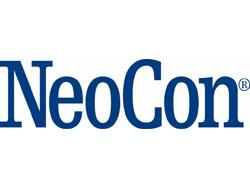NeoCon Reports on Four Design Themes for 2025 Event
Chicago, IL, May 29, 2025-As the design community looks forward to NeoCon 2025, taking place at The Mart in Chicago on June 9 to 11, four influential design themes are gaining momentum-shaping the next chapter of the built environment. Aligned with this year’s narrative, “Design Ahead,” these directions––sensory-based design, cross-sector adaptability, material innovation, and resilience––reimagine how we work, play, learn, heal, and connect. Bridging disciplines and priorities, each trend is grounded by a human-centric philosophy and commitment to sustainability and wellness.
Dynamic programming and bold product introductions throughout the 56th edition of the show capture a compelling snapshot of these shifts propelling workplace, hospitality, retail, healthcare, and education spaces forward.
The Sensory Shift: Emotionally Intelligent & Inclusive Design
Emotional well-being and inclusivity are fundamental prerequisites for good design, with neuroaesthetic principles guiding multi-sensory environments that reduce stress, promote healing, and enhance social connection. According to JLL’s Outlook on Design Trends 2025, 58% of employers surveyed cited cultivating culture and belonging as leading motivators for returning to the office, while 46% emphasized meaningful interpersonal connection.
As the concept of design as a therapeutic tool becomes more widely understood, biophilic design strategies, informed by neuroaesthetics, are reimagining both healthcare and commercial interiors.
Wellness also plays a crucial role in this boundaryless approach. IIDA’s Five Trends in Healthcare Design emphasizes flexible layouts, warm finishes, and natural light as essential for well-being. In hospitality, this concept now shapes everything from in-room features to adaptive programming.
Design Without Boundaries: Mobility, Modularity & Multi-Use Spaces
As the lines between work, learning, hospitality, and retail blur, today’s interiors must support multiple modes of engagement-transforming seamlessly from workspace to lounge, classroom to event space. (Think airport lounges doubling as remote workstations and hotel lobbies seamlessly transforming from quiet work zones to vibrant cocktail hubs.) This shift has made mobility, adaptability, and user autonomy essential.
Materials & Technology Revolution: The Rise of Circular & Smart Design
Sustainability is no longer optional-it’s a driving force in product development and design decisions. Gensler’s 2025 Design Forecast highlights the emergence of a “materials revolution”-driven by the urgent need to address climate risk, carbon reduction, and transparency. Clients are demanding low-impact, circular materials that align with ESG goals and brand values.
This realignment has a clear business case: PwC’s State of Decarbonization Report states that sustainable products can deliver up to 25% revenue gains, and a global sustainability study from IBM found that 69% of executives believe sustainability should be a higher priority. In fact, a Marsh McLennan study notes that companies with lower carbon emissions tend to have higher employee satisfaction.
Weathering the Future: Designing for Durability, Longevity, Human & Environmental Resilience
As climate instability, public health concerns, and global supply chain disruptions persist, resilience has become a critical design imperative. ThinkLab reports that 65% of A&D professionals now cite durability as their top product selection factor-marking a pivot toward long-lasting, high-performance solutions designed to meet the challenges of aging infrastructure, climate volatility, and everyday wear. Reinforcing this urgency, ASID’s 2025 Trends Outlook notes that rising natural disasters and temperature extremes are worsening indoor air quality and water safety-highlighting the need for robust, health-focused design solutions.
Related Topics:American Society of Interior Designers (ASID)
